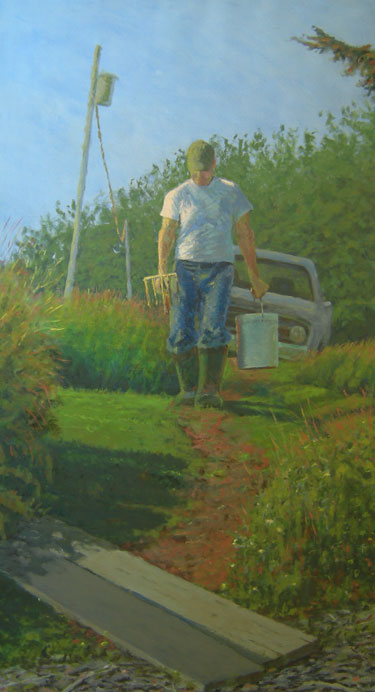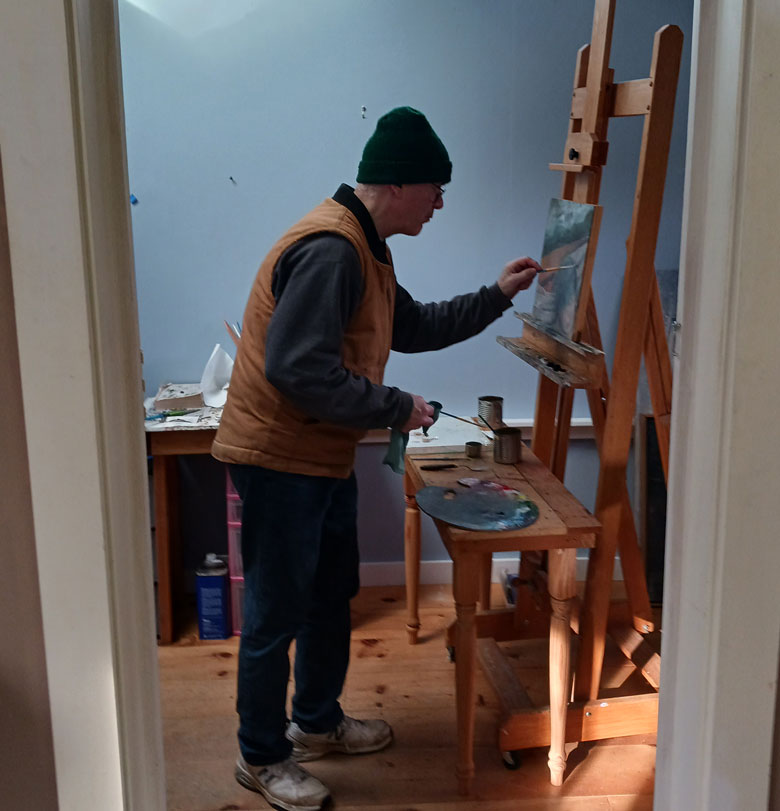At the time he painted “The Harvester” in 2012, William Landmesser of Stockton Springs remembers that concern about diminishing access to shorefront in Maine was growing.
“The boom in waterfront real estate meant potentially much less access by both commercial fishermen and the recreating public,” he recalled. He welcomed legislation drafted by communities to require “at least some places” be designated open to locals and visitors.
Landmesser himself wanted to be able to get to the shore to paint. One day he found himself on Summer Street in Searsport where he parked and followed a path to a gravel beach. Looking back, he saw a possible motif: his truck, the pathway, and a clamdigger walking to the water. Wanting to get a photo of the scene, he recruited some tourists from Canada to take one with his camera, making him the model for the figure in the painting.
“Painting involves listening with the eyes. It is an opportunity of learning to listen, which deepens faith.”
In T-shirt, jeans, and boots the man walks toward us, head bent, a clam rake in one hand, a bucket in the other.

“I guess the painting could be thought of as an allegory, the harvester as one who brings good news,” writes Landmesser, who often turns to his faith in considering the messages in his work. His interest in conveying religious themes in a “contemporary, non-threatening way” compels him to place figures in the foreground. He hopes that form and content will “speak truth visually, perhaps as a metaphor for body and blood, soul and divinity.”
Some of Landmesser’s earliest memories are related to Searsport. Every August, his family would caravan from Albany to Maine in two cars, each vehicle towing a small boat. Settled at their shoreside farmhouse, called “The Anchorage,” they would take the father’s lead and “work hard and play hard.”
Landmesser remembers walking to “uptown” Searsport, into “another pristine culture” that featured a “soda-fountained drug store, pea-shooter straws, and ‘ammo’ from First National Grocery.” The family took occasional day trips, some by boat, to Camden, Castine, Belfast, and “especially Acadia.”
A visual child, Landmesser found himself most impressed with “white clapboards, beautiful boats, jagged trees, rocks, whitecaps, knife-sharp light alternating with gray soup.” While he showed little interest in making drawings or paintings during these vacations, he was obsessed with “the look of things.”
A biology major at Dartmouth, Landmesser took studio art electives, studying with an impressive group of artists that included Ashley Bryan and Varujan Boghosian.
“I felt vulnerable to the freedom of expression that Bryan and Baghosian modelled,” he recalls, “yet that trait is still a guiding star as I practice the path of fine art in a place where paintings of lighthouses are in demand.”
In the late ‘70s Landmesser “found his calling” at the Art Institute of Boston: to pursue fine art rather than illustration. He learned to draw in a holistic way, thanks to the teachings of Nathan Goldstein and Patricia Cobb.
Returning to the family summer home in Maine in 1980, Landmesser rediscovered the subjects that had attracted him as a child. “Love, at the hands of painting, existed,” he recalls thinking.
Later, in New York City, Landmesser came across a painting by Fairfield Porter, a painterly realist with strong Maine ties.
Attracted by the artist’s style, he sought out Robert Dash, who had painted with Porter, and ended up spending several months in his studio on Long Island, N.Y., where he developed a “somewhat abstract” impressionist style.
While there, Landmesser experienced a spiritual awakening, which led him to the Gordon-Conwell Theological Seminary in Hamilton, Mass., where he earned a master’s in theological studies, met his future wife, fellow student Shirley Pike, and painted whenever he could. In 1989 they moved to Stockton Springs, to a place they call “Fern Hill,” where they have lived ever since.
“Painting involves listening with the eyes,” Landmesser says. “It is an opportunity of learning to listen, which deepens faith.”
That faith has given him the strength to persevere in making paintings that might eventually, he hopes, “speak to beauty, goodness and truth.”
You can find more of Landmesser’s work at LandmesserFineArt.com and at his Narrows Art Gallery in Stockton Springs, which is open “by chance or appointment.” He recommends calling a day ahead: 207-567-4302.





